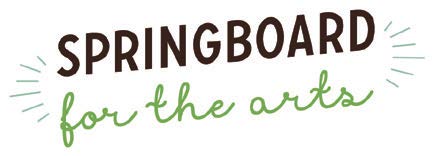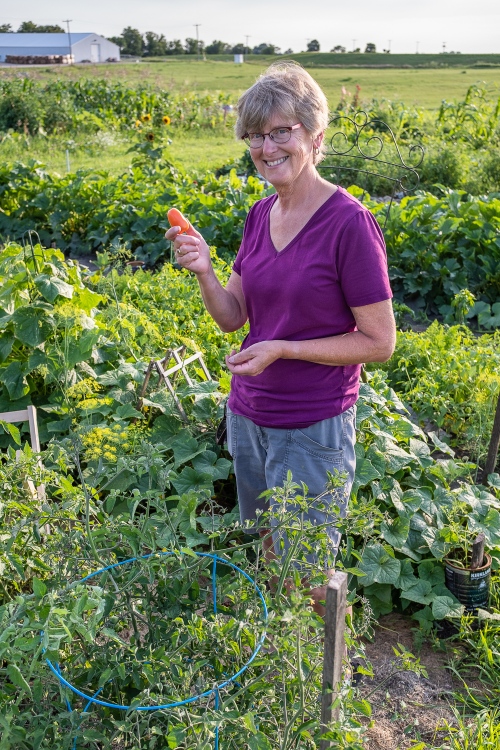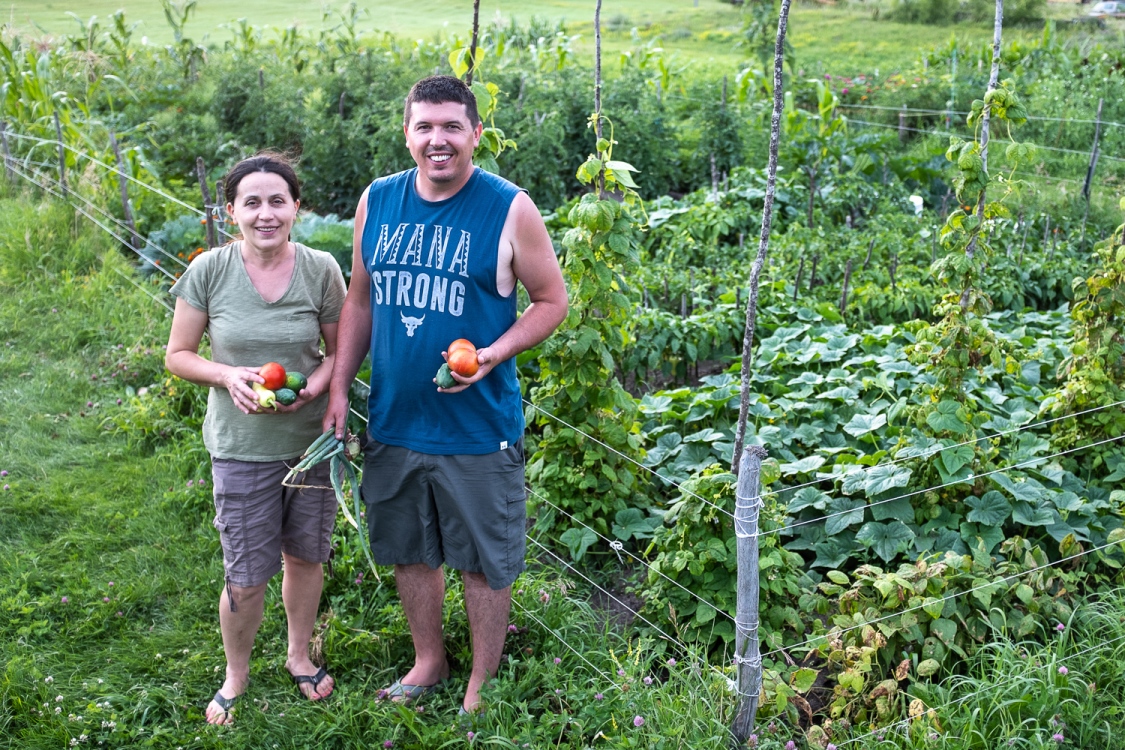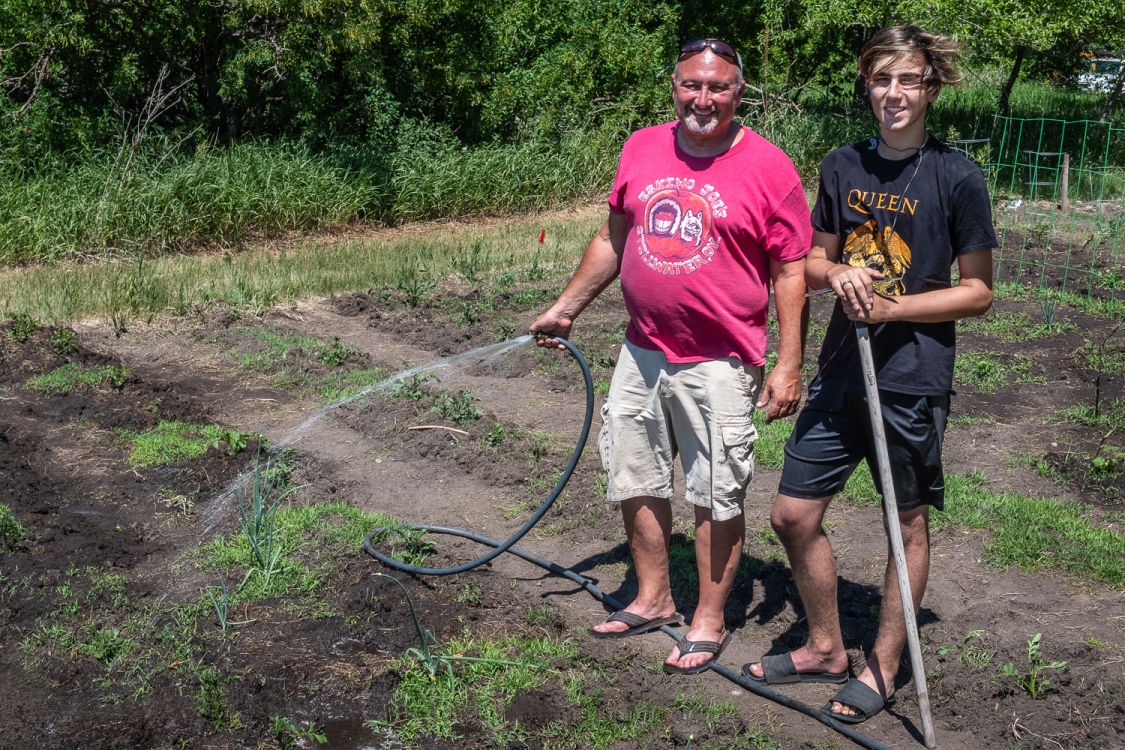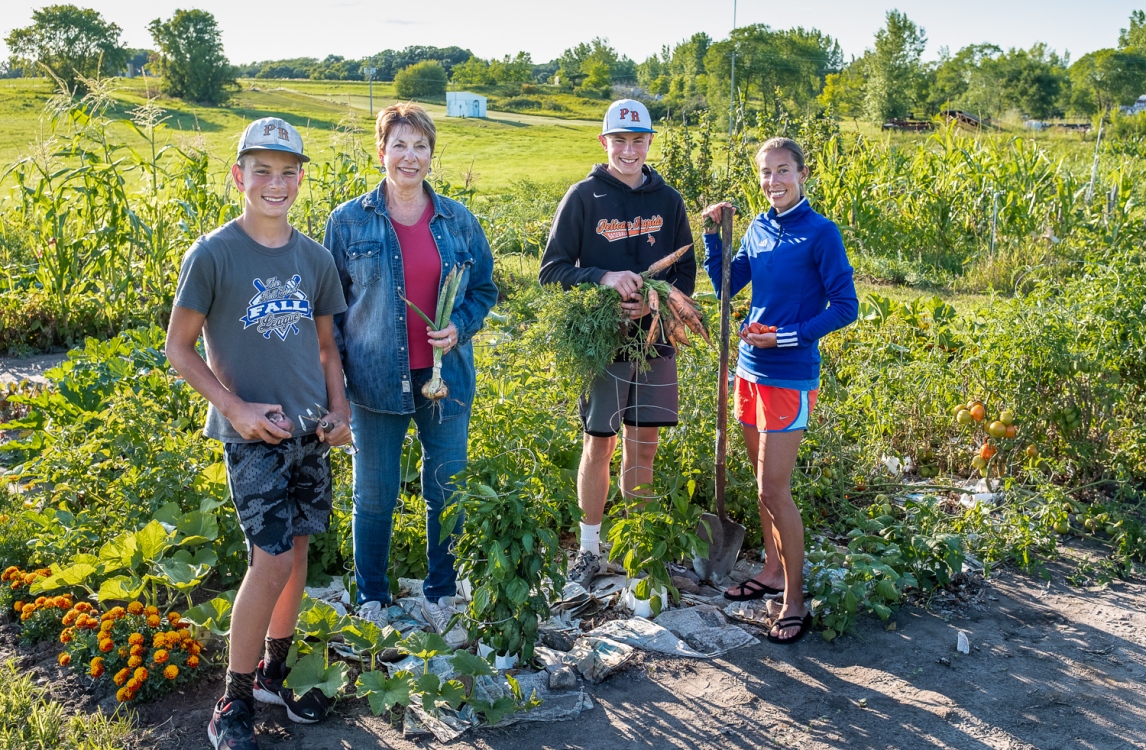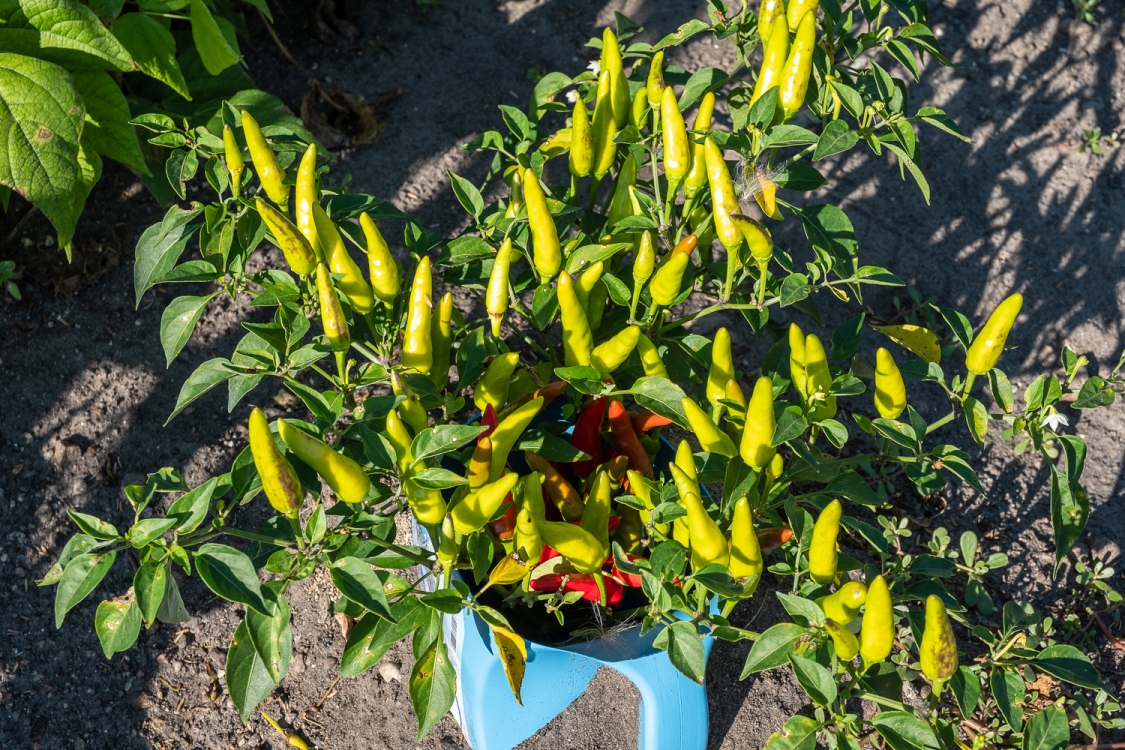I enjoy making portraits of people at work, but not only at the work that pays the bills. Community Gardeners receive rewards of the non-monetary kind: delicious fresh produce for themselves and for sharing, the satisfaction of useful hands-on work and a sense of intimate connection to a plot of land, their source of food and the cycle of seasons. Perhaps most importantly, they gain closer bonds with family and fellow gardeners through this work.
To make more complete portraits of people and place, I asked the participants to give me something of their own making that reveals motives and emotions from their gardening lives. They created beautiful maps, drawings and writings from the heart. These self-portraits complement my photographs, which only document the surface appearance of things.
Julie
Julie was raised in a family of gardeners in Newfolden Minnesota and has lived and gardened in the Pelican Rapids area for the last 30 years. She became involved in the Community Garden early in its history, when she found herself in need of a new garden site. She has since become Community Garden Coordinator and generously shares her know-how with others. In her Coordinator role she keeps track of who uses which plot, reserving them for successive years and assigning new gardeners a space of their own. She welcomes new participants; the plots now total 38, with enough land available to double that number if needed. She also offers a group garden for those who enjoy working and learning together, sharing the labor and the rewards. Their motto is “Growing Together.”
I asked Julie to reflect on the garden’s value to the community: “We obviously enjoy growing our own food in the community garden, but a community garden is much more than that. We become friends with our garden neighbors and share ideas, frustrations, laughter and successes with them. We may come from different backgrounds and cultures, but gardening brings us together.”
Julie drew a map of her own plot illustrating what vegetables she raised in 2020, adding notes to record the personal significance of her gardening experience. She has created a document rich in personal history, a self-portrait that complements the photographic portraits.
Julie’s strong family gardening heritage comes through clearly in these notes; she writes about what past generations gave her that still lives in her memory, and is expressed through her own gardening. A few examples: “I think I inherited my love of digging in the dirt from my parents and grandparents. Dad grew veggies; Mom grew flowers and canned/froze produce.” “Fall canning of tomatoes is a long-standing family tradition! Every year I miss Mom helping me…” She reveals the poignant meaning of flowers: “zinnias, the first flower I planted with Grandma Starr” and gladiolus, “Includes Mom’s bulbs from my childhood.”
Julie also completed an eight-segment circular timeline of garden tasks—the growing season goes round and round with the years—one segment for Winter, dormant time, and a segment each for April through October. She notes only the joyous labors of love and delicious harvests.
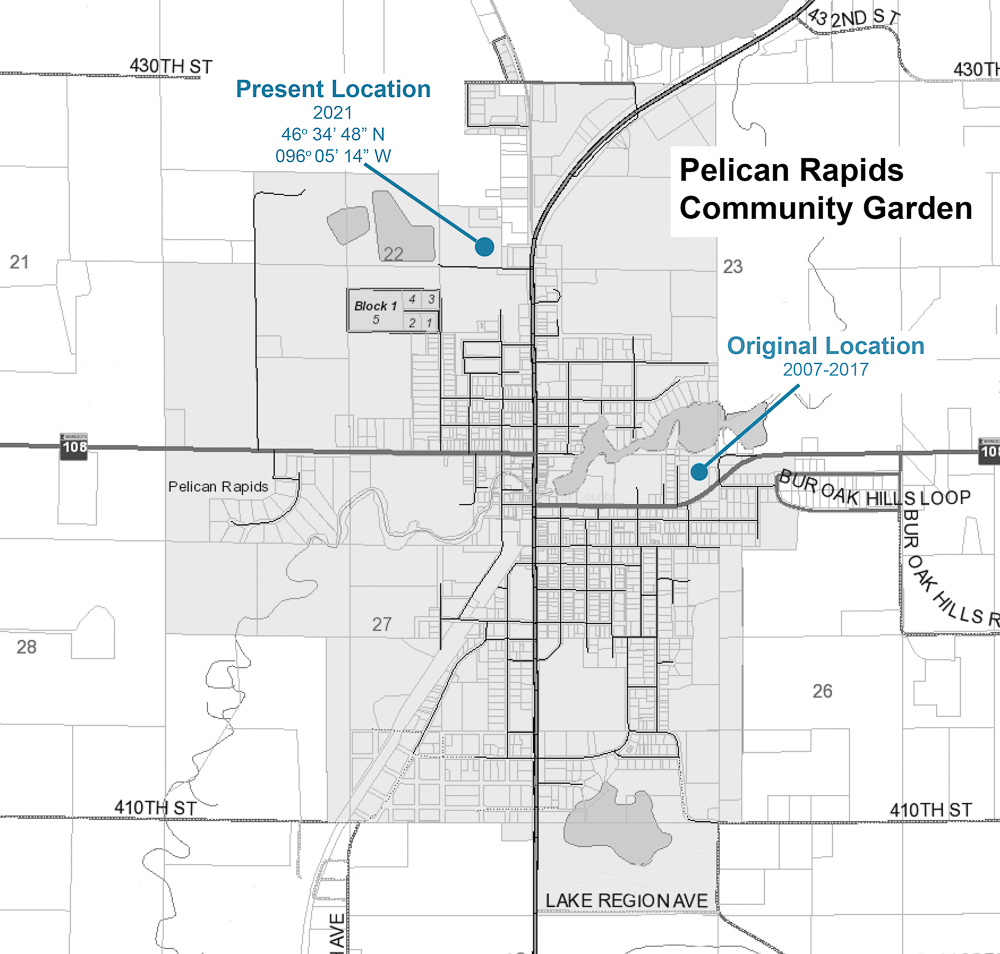
Pelican Rapids Community Garden History
Janet Lindberg, Pelican Rapids Food Shelf Board Member
2020
How long has the garden existed? This next year will be the 13th year.
The Community Garden was established in 2007 as the result of a WIC (Women Infants and Children) grant. The goal was to provide gardening space for our WIC recipients in Pelican Rapids to grow their own food. The garden was located on Cecil Femling’s land (he was willing to host the garden). Everett P. Erickson, then a county commissioner, dug up the land. We had 8 garden plots. There were about three WIC moms who had plots, the excess land was opened to lower income people, and a couple of plots were raised for the food shelf.
We provided:
- Space to garden (8×10 plot)
- Seeds to plant
- Water
- Garden tools
- Help to get started – we had the Master Gardeners available to help plan and plant.
The next year it grew to 20 plots. Otter Tail County Extension was also very helpful in developing the garden. We received free seeds from “garden day” and resources for “how to start a community garden”.
We learned two things the first year:
1) WIC moms are very busy; it was difficult to maintain the gardens on their own.
2) It did not cost much to initiate the garden because people were so generous with donating space, tools, and help. We gave much of the grant back!
In the next few years, we received fruit trees and a pump to bring irrigation water from the river. After 10 years, we moved to City property as Cecil passed away and his land was sold.
After the first year, the community garden was put under the auspices of the Pelican Rapids Food Shelf. People who garden, donate to the food shelf (recommended $5 donation initially, now $20 if they are able. They are also encouraged to give excess produce to the food shelf. The money goes to pay the water bill. We have received two additional $1,000 grants (Walmart & PartnerSHIP 4 Health) for irrigating the garden, buying hoses, carts and equipment.
In 2019, a high school student received a grant to garden two plots for the food shelf. We ran a “Food Shelf Farmers Market” on food shelf distribution days. Food shelf participants were invited weekly to receive fresh garden produce for free. It was really fun to give them high quality produce! In 2020 PartnerSHIP 4 Health awarded the Garden a grant for an “equipment library” that features a walk-behind tractor with attachments for laying plastic and digging potatoes, along with a trailer so the equipment can be shared with community gardeners across a four-county region.
We currently have 34 plots available, they are 26’x 30′ – so much larger. Julie Tunheim has been an awesome garden coordinator who can keep the garden full of participants….as well as share her garden expertise!
Raza
Raza became a Community Garden participant at its original location in 2009, later establishing a new plot on its current site next to the Pelican Rapids water tower. However, her local gardening history began prior to the establishment of the Community Garden in 2007. After Raza and her husband Saban came to Pelican Rapids in 1998 to escape war in Bosnia—choosing to come here because she had a cousin in the community—they lived in an apartment without garden space, but gained access to land at a friend’s home in the nearby countryside.
Raza’s parents raised her on a small farm in Bosnia, with a large garden, chickens and cattle, much like Otter Tail County farms of the past, on which families produced much of their own food. Together with Saban and their son Elvis, she now raises vegetables familiar to her family’s food traditions, and from her upbringing she learned how to plant and when to harvest. She has taught herself much more about gardening through years of experience. The heritage she carried with her from Bosnia includes the way she prepares meals with fresh produce from her garden, and methods of preserving some of the harvest to enjoy through the winter season.
Emotional benefits rank high for Raza also. She enjoys a sense of relaxation while working in the garden, looking forward to fresh produce free of pesticides. She tends her garden often, doing the hard work of weeding and watering, carefully maintaining the plants as they mature toward harvest. While speaking with Raza I felt her pride in raising a beautiful and productive garden and in making beautiful, delicious food for her family.
She expresses as much joy while describing how she prepares meals from her harvest as she does for the activity of gardening. I asked her to write down in the Bosnian language how she makes some of her favorite dishes, and to have her son Elvis add an English translation. She doesn’t keep these on a collection of recipe cards; these are part of her, part of her family heritage.
Rob and Tate
Father and son tend a Community Garden plot, intentionally spending time together, sharing experiences and the delicious rewards of their labor. This is their third year at the Garden, but it’s not the first place where they have bonded through a shared activity. Rob and Tate also camp at Maplewood State Park, where they canoe, bike and prepare meals over a campfire. Naturally, when the idea of gardening came up, they were ready to do it together.
For Tate, an inspiration to begin gardening came through a book he read on canning, juicing and preserving food, in particular, a chapter on making beverages at home from various plants. He treated me to a glass of rhubarb juice during our interview. The distinctive flavor of rhubarb reminded me of what my father called his “spring tonic.”
Rob grew up as a town kid in Grand Forks, North Dakota, but remembers visiting and helping out at his grandparents’ farms. Rob’s ancestors produced and preserved much of their own food from large gardens, as many rural dwellers did in earlier times. He recalled one occasion picking strawberries with his grandfather, who exclaimed “don’t smoosh ‘em!” in his Swedish accent.
Tate told of another instance of instruction given from an older generation to the younger: Rob asked him to prune some lower leaves from potato plants, but he followed the instructions too literally, overdoing it until Rob intervened. It became one of those “Wait! What are you doing?” moments familiar to parents.
Tate’s foremost motive for gardening is the superior quality of fresh home-grown produce; it just tastes so much better. He also appreciates the money-saving and self-sufficiency benefits of gardening. His favorites: carrots, cucumbers and potatoes. Potatoes may be the winner; the spud section of the Jacobson garden has grown larger every year so far.
Beth and Family
2020 was Beth’s third year working a plot at the Community Garden, but gardening has long played a significant role in her life. Her parents raised a small garden during her childhood, and her husband—raised in a farming family who depended on a large garden and home canning to help feed its members—introduced her to the benefits of gardening at their first home together. Knowledge of canning and freezing vegetables for later use passed from mother-in-law and sister-in-law to Beth. She now enjoys time spent with the next two generations of her family, experiencing together the joys and challenges of working the soil to produce wholesome food.
Three generations tended this garden in 2020: Beth, her daughter Jackie and Jackie’s sons Charlie and Grady. Because the COVID-19 pandemic shut down Charlie’s and Grady’s usual summer youth activities, they could spend time working with Beth and Jackie at the garden plot from beginning to end of the growing season: tilling, planting, thinning, weeding, then harvesting the rewards of their work, and finally, fall clean-up.
I can imagine the family’s memorable times together in the garden, learning new things while passing forward a gardening heritage, and simply being there to experience the miraculous making of food from soil, water and sunshine.
I asked Beth to draw a map of her family’s garden plot and write something about what the Community Garden means to her. A few weeks later, she gave me a hand-written history of her gardening life—I love handwritten documents, so expressive but becoming rare—and a beautiful garden map with detailed color illustrations of her garden’s produce. Grandsons Charlie and Grady each wrote a paragraph of their thoughts on tending the garden, such as “knowing that you planted seeds and they turned into vegetables” and “even though you can buy it at the store gardening is cheaper and you don’t have all these chemicals that are on the produce at the store.” Also, some downside: “when you are on the ground, there is always the possibility of some beetle or maggot crawling on you.”
The Produce
I want to thank the project participants and funders for this opportunity. It was great to learn about the gardeners and what a special asset the Community Garden is to Pelican Rapids.

